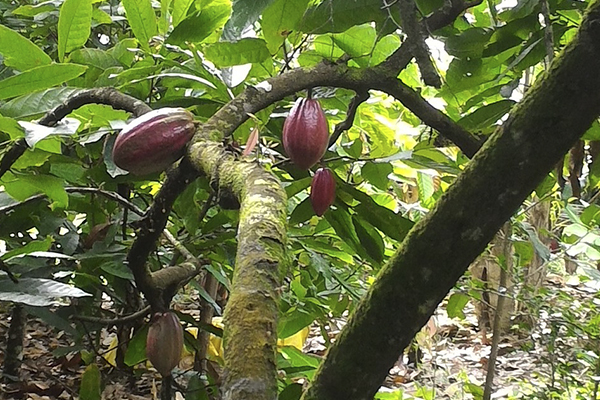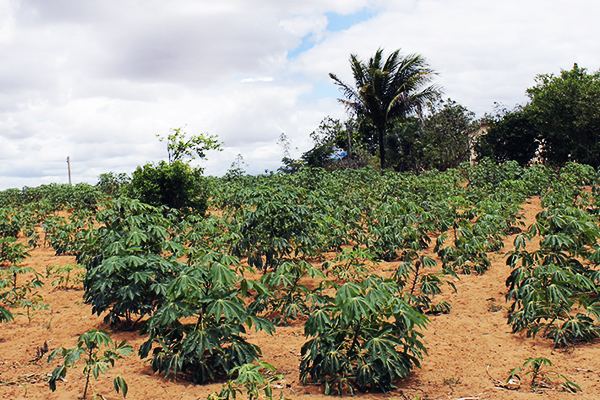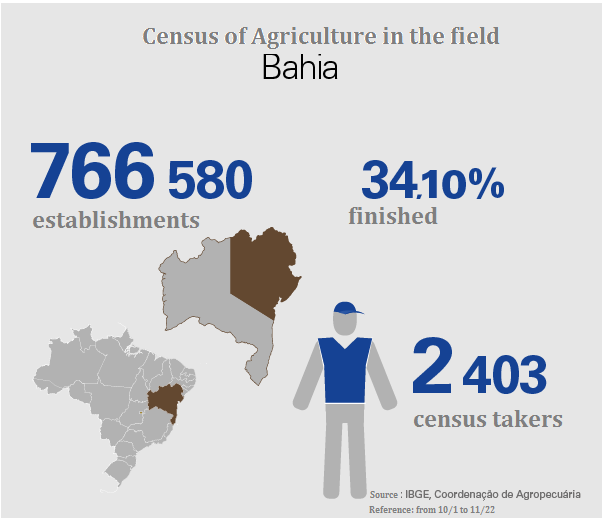From cacao to cassava: drought leaves a trace in the Census of Agriculture in Bahia
November 27, 2017 09h00 AM | Last Updated: June 05, 2018 03h50 PM
On muddy and bumpy roads, crossed by cows, some distrustful respondents and angry dogs, census takers of the Census of Agriculture 2017 break into the rural areas of each Brazilian Region in search for information to depict the agricultural sector of the country. And the same goes to Bahia, the Brazilian biggest rural state.
But a census taker does not live by distress alone... Those roads, sometimes with room for just one motorcycle each time, are welcoming and full of stories behind each questionnaire. There is the couple that refuses to leave the land, even with the fragile health condition; there is the farmer that does not only answer the questions but also is moved when remembering his imprisonment and torture during the Military Regime. Simple and hospitable people that do not admit that the census taker leaves before having at least a cup of coffee. Sometimes, there is even a meal and homemade chocolate!!
"Everybody is hospitable and wants us to have something to drink. They even get upset in case of refusal. Then they prepare sugarcane juice, fruit juices", says census taker Thalita Moreno, who is working at the municipality of Ilhéus, in the south of the state. She claims that she counted on the help of a local dweller to get to difficult access properties, and, this way, she finished one of the enumeration areas of Ilhéus in two weeks' time.
The area Thalita finished is among the 1,732 that had been concluded until November 24 this year in Bahia. The figure represents almost 13% of the 13,250 areas in the state. The collection for the Census of Agriculture 2017 in Bahia has already began and finished in more than 43% of the total area.
"The collection is going just fine. It has finished in almost 2 thousand enumeration areas and is being carried out nowadays in almost 2.3 thousand areas. Now the expectations are focused on the supervision, payment and the remaining establishments as well as on data quality", claims operational coordinator of the Census of Agriculture in Bahia, André Urpia.
Drought and plague in Bahia: sad but true
Little by little, the rural picture is being drawn. In Ilhéus, for instance, census takers came across a sad reality: the main producing municipality of cacao in Bahia and the second biggest in the country has been fighting a fierce battle against the droughts and Witches' Broom. From 2015 to 2016, the production in the state fell a little more than 42 thousand metric tons, according to the results of the Municipal Survey (PAM), of the IBGE.

Ilhéus is the biggest cacao producer of Bahia
"The production of cacao is also affected by the plague Witches' Broom. So they [producers] are planting cupuaçu in the cacao lands, but half of the cucpuaçu is lost because there is no market to it. During the interview, we can feel that sad, heavy kind of look on their faces", says Thalita.
Because of such loss, rural producers are closing establishments, which makes the information collection even more difficult: "As there are new producers, the collected information will be just on the planting, since there was not time for harvest in the reference period", explains the supervisor Andrea dos Anjos.
The drought issue occurs in other regions of Bahia. In Serrinha, in the northeast of the state, the lack of rainfalls ruined a lot of crops, as says farmer Jucelino Cardoso. "The weather here some time ago used to be pretty good, but today it is hard because it is not always possible to harvest the crops. This year we also had some beans, but we lost almost 90% of the corn crop”, he says.
One of the census takers of the region, Lucas Costa confirms it: "The profile [the way I see it] is of subsistence because lately the weather has not been favorable. Production fell, so there is nothing left for trading", he says, explaining that the most common crops up to now are beans, corn and cassava. "What stroke me the most was the fact that those people were in a precarious situation, living by the crops and they don't have other means to make a living", he says.

Cassava is another product affected by the drought
In Barreiras, west of Bahia, a region with a high value agricultural production, concentrated mostly on grains, such as soybeans, and on cotton, the same applies, as explains census taker and agricultural engineer Maxuel Araújo. "There has not been rain yet this year and, of the areas I visited and which are irrigated, some decreased the amount of irrigation", he says, complementing that some producers are preparing the land while they wait for the rainfall expected for the first fortnight of November.
This is just a sample of the agricultural reality of Bahia, collected from the properties visited by Thalita, Lucas and Maxuel, which are in the group of the more than 260 thousand establishments surveyed until November 22, corresponding to nearly 34.1% of the total amount expected for the state (around 760 thousand).
Up to the end of the collection, February 2018, many other profiles will have been unveiled, as explains IBGE State Branch Chief in Bahia (UE/BA) Artur Ferreira Filho: "The objective of the Census of Agriculture is to inform through numbers the model and structure of the producing system of the sector. Obviously, the regions where the production is mostly affected will be shown too, for instance, those regions where crops which are not well adapted were affected by weather factors. The Census will also show regions where the situation is different", he clarifies, adding that the results of the Census of Agriculture can favor rural producers.
"The Census can benefit the farmer, because, with the data analysis, governments can focus on public policies to those areas where the weather condition is severely affecting the crops or propose a change in the producing system, fostering a more drought-resistant crop. And as to the areas that are already benefited by the weather conditions, it can encourage even more the productivity increase.

Text in Portuguese: Rita Martins
Photos: Rita Martins and Thalita Moreno (Census taker)
Art: Valberto Alves
Infograph: Pedro Vidal


















